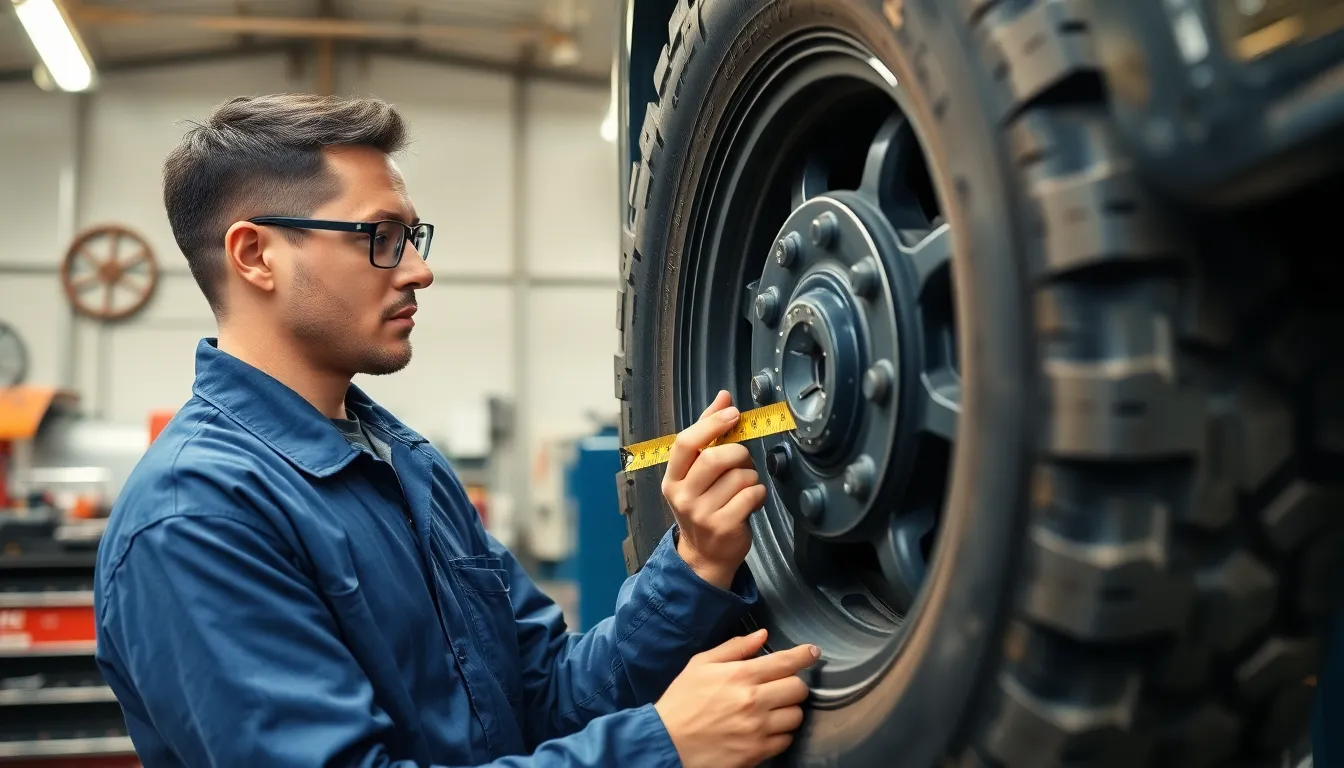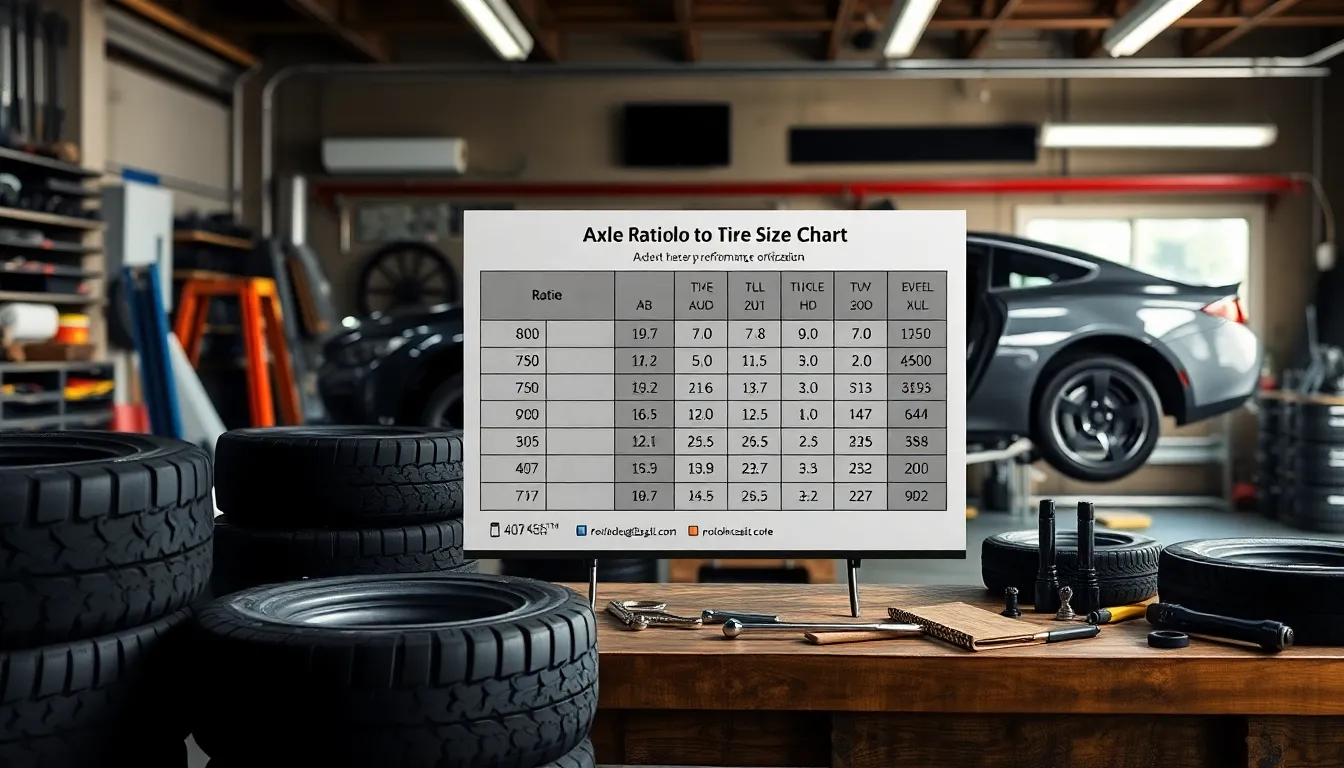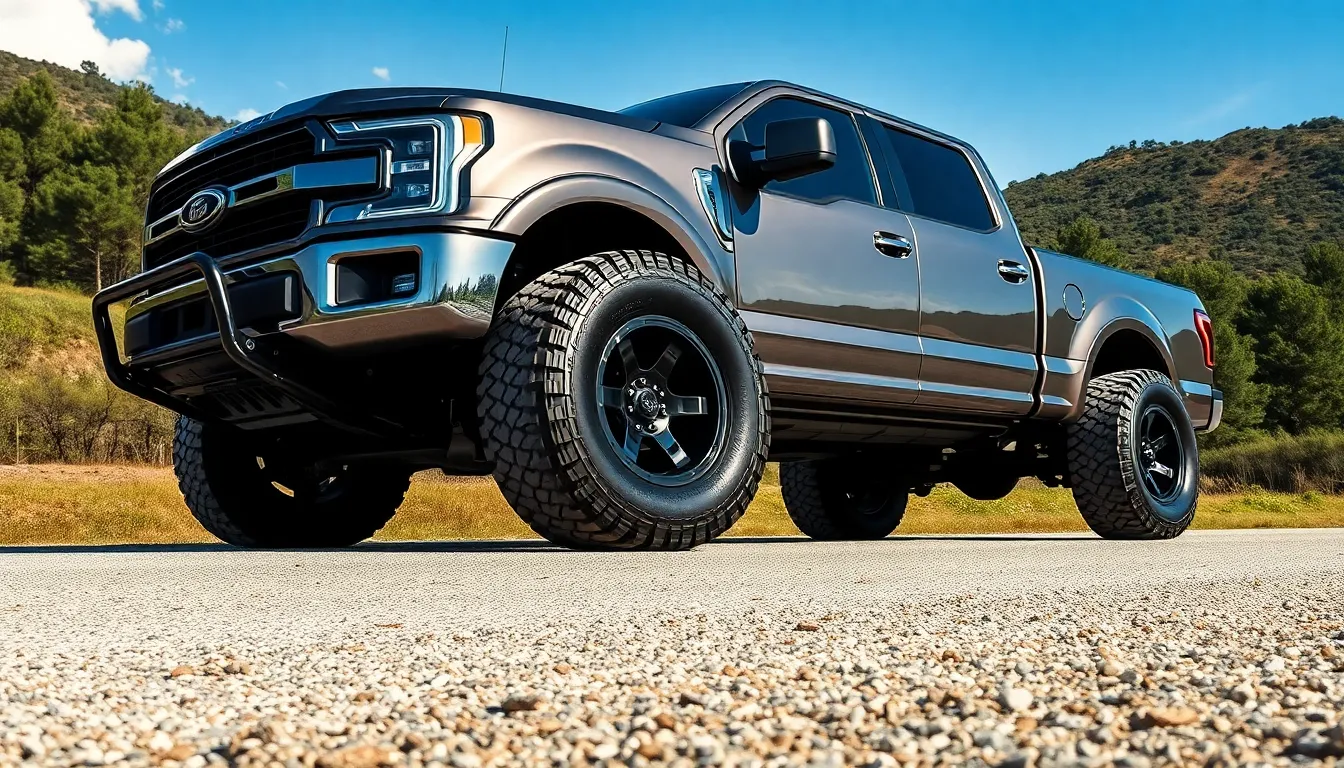Are you struggling to find the perfect axle ratio to tire size combination for your vehicle? Getting this relationship right is crucial for optimal performance, fuel efficiency, and overall driving experience.
When you upgrade your tires or modify your vehicle, understanding how axle ratios interact with tire dimensions becomes essential. The wrong combination can lead to poor acceleration, reduced fuel economy, or excessive strain on your drivetrain. That’s why having access to a reliable axle ratio to tire size chart can save you from costly mistakes and help you achieve the performance you’re looking for.
Understanding Axle Ratios and Their Importance
Axle ratios represent the number of times your driveshaft rotates to turn your wheels once. A 3.73:1 ratio, for example, means the driveshaft completes 3.73 revolutions for each complete turn of your wheels. Higher numerical ratios (like 4.10:1) provide more torque multiplication, ideal for towing and off-roading, while lower ratios (like 3.08:1) favor highway cruising and fuel economy.
Your vehicle’s axle ratio directly impacts several key performance aspects. Torque multiplication affects how quickly your vehicle accelerates from a stop. Fuel efficiency changes based on how hard your engine works at highway speeds. Towing capacity increases with higher numerical ratios as they provide more mechanical advantage. Overall driving experience, including throttle response and engine RPM at cruising speeds, is largely determined by this crucial specification.
Liam Kohn, our off-road specialist, discovered this firsthand when upgrading his F-150. “I switched from the stock 3.55 gears to 4.10s after installing larger tires, and the difference was night and day. My truck felt like it had gained 100 horsepower, especially when pulling my boat up steep launch ramps.”
Modifying your axle ratio offers tangible benefits in exact situations. Off-road enthusiasts gain improved rock-crawling ability and better control on technical terrain with higher numerical ratios. Heavy towers experience reduced transmission strain and cooler operating temperatures. Daily drivers seeking better fuel economy often benefit from lower numerical ratios that let the engine run at lower RPMs on the highway.
The interaction between tire size and axle ratio creates a mathematical relationship that determines your vehicle’s final drive ratio. Increasing tire diameter effectively raises your gearing, while decreasing tire size lowers it. This relationship explains why larger tires often necessitate axle ratio changes—they cancel out some of the mechanical advantage provided by your differential.
The Relationship Between Axle Ratios and Tire Sizes

Axle ratios and tire sizes share a direct mathematical relationship that significantly impacts your vehicle’s performance. The axle ratio, typically expressed as a numerical value like 3.55:1, indicates how many times the driveshaft must rotate to turn the axle shaft once. Tire size, measured by diameter, works together with this ratio to determine your vehicle’s final drive ratio, affecting everything from acceleration to fuel economy.
How Tire Size Affects Vehicle Performance
Larger tires create a substantial impact on your vehicle’s performance characteristics without corresponding axle ratio adjustments. Your acceleration and towing capacity decrease when installing bigger tires because they require more torque to rotate effectively. Higher numerical gear ratios compensate for larger tires by increasing torque at the wheels, restoring lost performance. Fuel economy and engine RPM levels change dramatically with tire size modifications – larger tires paired with stock gearing lower engine RPM at cruising speeds, potentially improving highway fuel economy but risking engine lugging under load. Speedometer accuracy suffers with tire size changes since the rolling circumference directly affects distance traveled per revolution, causing your speedometer to display incorrect speeds unless recalibrated.
Finding the Optimal Balance
Determining the ideal axle ratio for your exact tire size involves using specialized gear ratio-to-tire size charts or calculators designed for this purpose. These tools factor in tire diameter to recommend appropriate gear ratios for different driving scenarios. A practical rule of thumb multiplies your tire diameter by 0.12 to estimate a suitable axle ratio – for example, 38-inch tires would pair well with approximately 4.56 gears. Gear ratio charts typically suggest ratios between 2.7-3.5 for maximizing fuel economy during highway cruising, moderate ratios around 3.5-4.1 for balanced everyday driving, and higher ratios above 4.1 for enhanced towing capacity and off-road performance. Larger diameter tire installations almost always necessitate increasing your numerical axle ratio to maintain original performance characteristics, while smaller tires might allow for lower gear ratios. Professional consultation remains essential when making these modifications to ensure compatibility with your vehicle’s drivetrain and suspension systems for optimal power delivery, efficiency, and safety.
Comprehensive Axle Ratio to Tire Size Chart

Axle ratio to tire size charts help match your vehicle’s axle gear ratio with tire diameter to optimize engine RPM, fuel economy, performance, and drivability. These charts display how different axle ratios (typically 2.73:1 to 4.88:1) interact with various tire diameters (24″ to 37″) to affect engine RPM at common highway speeds. Using these charts effectively requires identifying your current tire size from the sidewall, finding your axle gear ratio in the owner’s manual, and then consulting the chart to maintain ideal RPMs (typically 2,000-3,000 RPM at highway speeds).
Common Ratios for Passenger Vehicles
Passenger cars typically feature axle ratios between 2.73:1 and 3.91:1 paired with tire sizes in the 24″ to 28″ diameter range. A 2.73:1 ratio with 25″ tire diameter maximizes fuel economy but provides less low-end torque for acceleration. The middle-ground 3.55:1 ratio with 26-27″ tires offers a balanced combination of acceleration and efficiency for daily driving. Higher numerical ratios like 3.91:1 significantly increase torque for better performance, particularly for smaller cars needing additional power, though fuel economy decreases proportionally. Many sedan owners find that staying within this range maintains their vehicle’s intended performance characteristics while allowing for minor tire size adjustments.
Optimal Ratios for Trucks and SUVs
Trucks and SUVs generally run higher axle ratios between 3.73:1 and 4.88:1 to multiply torque for towing and hauling capabilities. These vehicles often use larger tires from 28″ up to 37″ for ground clearance, off-road performance, or aesthetic appeal. A 3.73:1 ratio paired with 33″ tires creates a common configuration for daily-driven trucks that balances power and highway drivability. Heavy towing or off-road applications benefit from 4.10:1 to 4.88:1 ratios with 35-37″ tires, improving crawling ability and acceleration under load while accepting increased engine RPM at highway speeds. Truck owner Liam Kohn discovered this firsthand after upgrading his F-150 with 35″ tires, noting, “I had to switch from my stock 3.55 gears to 4.10s to maintain the pulling power I needed for my boat trailer while preserving reasonable highway fuel economy.”
Off-Road Vehicle Considerations
Off-road vehicles demand specialized gear and tire combinations to maintain power and traction over challenging terrain. Taller tires (35″ and above) combined with inadequate axle ratios cause engine lugging, poor throttle response, and compromised performance in technical situations. Dedicated off-road builds frequently use gear ratios like 4.56:1 or 4.88:1 to compensate for larger tires, ensuring sufficient torque multiplication for obstacle clearing and hill climbing. Transmission gear ratios and overall gear reduction must be considered to maintain acceptable RPM ranges across various driving conditions. Following the chart prevents situations where RPMs at cruising speeds climb too high, creating excessive noise and dramatically reducing fuel economy. Experienced off-roaders emphasize the importance of this balance, as incorrect gearing can transform an otherwise capable vehicle into an underpowered, inefficient machine on both trails and highways.
How to Read and Use an Axle Ratio to Tire Size Chart

Axle ratio to tire size charts serve as essential tools for maintaining optimal vehicle performance when modifying your wheel and tire setup. These charts help you determine the ideal gear ratio that complements your tire dimensions for balanced performance, fuel economy, and drivability.
Calculating the Ideal Ratio for Your Vehicle
Determining the perfect axle ratio for your exact tire size involves a straightforward mathematical calculation. Start by measuring your current tire diameter and comparing it to your planned new tire size. The percentage change in tire diameter should be matched by a proportional change in your axle ratio. For larger tires, multiply your current axle ratio by the percentage increase in tire diameter. A 16% increase in tire diameter means a 4.10 axle ratio should be increased to approximately 4.75 or 4.88 for optimal performance.
To calculate your current axle ratio without disassembling the differential:
- Jack up one tire and mark both the tire and vehicle body at a reference point
- Mark the prop shaft and axle housing
- Rotate the tire exactly 10 full turns while counting prop shaft rotations
- Apply the formula: Gear Ratio = (Prop Shaft Rotations × 2) ÷ 10
For example, if your prop shaft turns 23.5 times during 10 tire rotations, your gear ratio is approximately 4.7.
Reading and Interpreting Chart Values
Axle ratio charts typically display tire sizes along one axis and gear ratios along the other. The intersecting values often represent engine RPM at highway speeds (usually 65 mph) or optimal performance indicators. Lower RPM values generally indicate better fuel economy but potentially reduced acceleration, while higher RPM values suggest better acceleration but lower fuel efficiency.
To read the chart correctly:
- Locate your tire size on the chart (formatted like P265/75R15)
- Find your current or desired gear ratio
- Check the intersection point for compatibility
- Compare multiple options based on your driving priorities
Remember that most charts represent ideal circumstances, so your real-industry results may vary depending on vehicle weight, aerodynamics, and driving conditions.
Practical Applications for Different Driving Needs
Different driving scenarios require exact axle ratio to tire size combinations. For highway driving and fuel economy, select a lower numerical ratio (like 3.08:1 or 3.23:1) with moderately sized tires to keep engine RPMs lower at cruising speeds. Daily driving typically benefits from balanced ratios around 3.55:1 to 3.73:1 with standard tires for good acceleration and reasonable fuel economy.
Towing and hauling applications demand higher numerical ratios (4.10:1 to 4.88:1) to provide the necessary torque multiplication, especially when paired with larger tires. Off-road enthusiasts often choose the highest available ratios (4.56:1 to 5.38:1) to complement oversized tires and maintain crawling capability on challenging terrain.
The chart helps identify these ideal combinations without requiring extensive technical knowledge. Cross-referencing your vehicle’s weight, intended use, and tire size with the recommended ratios offers a solid starting point for modifications.
Common Mistakes to Avoid When Using the Chart
Several common errors can lead to suboptimal vehicle performance when using axle ratio charts. Failing to account for additional vehicle modifications like engine tuning or weight changes might render chart recommendations less effective. Many charts don’t factor in transmission gear ratios, which can significantly affect overall performance calculations.
Misreading tire sizes represents another frequent mistake – remember that P265/75R15 refers to width, aspect ratio, and wheel diameter, not the actual tire diameter in inches needed for ratio calculations. To convert conventional tire measurements to diameter, use tire diameter calculators or manufacturer specifications.
Overlooking your exact driving needs can result in choosing ratios that excel in one area but perform poorly in others. Balance your priorities between fuel economy, acceleration, towing capacity, and off-road performance when selecting your ideal combination.
Real-World Applications and Performance Impact

Tire size and axle ratio combinations directly affect your vehicle’s real-industry performance characteristics. Understanding these relationships helps you optimize your vehicle for exact driving conditions and requirements.
Fuel Economy Considerations
Larger tires without appropriate axle ratio adjustments decrease your engine’s RPM at highway speeds, potentially improving fuel economy but reducing responsiveness. Your engine operates most efficiently at exact RPM ranges, with optimal highway fuel economy typically occurring around 2600 RPM. Adjusting axle ratios to complement your tire size maintains this sweet spot for efficiency. Numerically higher gear ratios increase engine RPM, which can raise fuel consumption if pushed too far beyond the optimal range. The relationship works both ways—smaller tires effectively increase your gear ratio, potentially raising RPMs and fuel consumption at highway speeds if not properly matched with an appropriate axle ratio.
Towing and Hauling Performance
Higher numerical axle ratios deliver increased torque to your wheels, improving pulling power when towing heavy loads or climbing steep grades. Your towing capacity suffers when you install larger tires without compensating with a higher axle ratio, as the effective gear ratio decreases and reduces available wheel torque. The strain on your engine increases when towing with an improper tire-to-axle ratio combination, potentially leading to overheating and premature wear. For serious towing applications, many truck owners find that a ratio between 3.73:1 and 4.88:1 provides the best balance of power and control when paired with appropriate tire sizes. Maintaining adequate engine RPM under load—typically around 3100 RPM for highway towing—ensures your vehicle has sufficient power reserves for challenging conditions.
Common Mistakes When Matching Axle Ratios to Tire Sizes

Ignoring Tire Diameter Variations
Tire diameter can vary significantly between brands even when the nominal size appears identical. These variations often lead to inaccurate gear ratio selection when not measured precisely. For optimal results, always measure your actual tire diameter rather than relying solely on manufacturer specifications. Different tire constructions and designs can alter the effective diameter by up to half an inch, which impacts your vehicle’s performance characteristics.
Not Considering Transmission Type
Transmission types dramatically affect the ideal axle ratio for your vehicle. Automatic transmissions typically run at higher RPMs compared to manual transmissions. Vehicles equipped with overdrive generally operate at lower RPMs than those with a 1:1 final drive ratio. This crucial factor gets overlooked when selecting appropriate gear ratios, leading to suboptimal performance. Your transmission’s characteristics must be factored into the equation when consulting axle ratio charts.
Overlooking Intended Use
Selecting a gear ratio based solely on fuel economy often sacrifices towing capability and acceleration. The color-coded zones on axle ratio charts help balance these competing needs – yellow zones (around 2600 RPM) maximize highway fuel economy, green zones (approximately 2800 RPM) optimize daily driving, and red zones (about 3100 RPM) enhance towing or low-speed power requirements. Many drivers select ratios without fully considering their actual driving priorities, resulting in disappointment with their vehicle’s performance.
Failing to Recalibrate After Tire Changes
Simply installing larger tires without adjusting gear ratios creates many performance issues. This common oversight leads to reduced acceleration, diminished towing capacity, and increased engine stress. The mechanical advantage changes significantly with tire size modifications, requiring corresponding adjustments to your axle ratio. Your vehicle’s computer systems, including speedometer and odometer readings, also need recalibration to account for the new tire dimensions.
Misinterpreting RPM Requirements
Many drivers don’t understand the relationship between engine RPM and vehicle performance at highway speeds. Running too low RPM (below 2000) at cruising speeds might seem fuel-efficient but can place excessive strain on the drivetrain and reduce engine responsiveness. Conversely, excessive RPM at highway speeds increases fuel consumption and engine wear. Your exact engine design has an optimal RPM range that balances efficiency, power, and longevity – consulting the proper charts helps identify this sweet spot.
Disregarding Vehicle Weight Considerations
Vehicle weight significantly impacts the ideal axle ratio and tire size combination. Heavier vehicles require more torque multiplication to maintain performance, especially when fitted with larger tires. Your vehicle’s weight, particularly when loaded with cargo or towing, should influence your gear ratio selection. Many charts don’t explicitly account for weight variations, requiring additional calculations or professional consultation for heavily modified vehicles.
Conclusion
Finding the perfect axle ratio and tire size combination is more than a mathematical exercise—it’s about optimizing your vehicle for how you actually use it.
Armed with the right charts and calculations you can now make informed decisions that enhance performance while avoiding costly mistakes. Whether you’re looking to improve fuel economy for daily driving or maximize torque for towing heavy loads your axle ratio choice matters.
Remember that the relationship between tire diameter and gear ratio directly impacts everything from acceleration to fuel efficiency. Take time to measure accurately consult with professionals when needed and consider your exact driving demands.
By applying these principles you’ll create a vehicle setup that delivers the perfect balance of power efficiency and drivability for your unique needs.
Frequently Asked Questions
What is an axle ratio and why is it important?
An axle ratio represents how many times the driveshaft rotates to turn the wheels once. It’s important because it directly affects your vehicle’s performance, fuel efficiency, towing capacity, and driving experience. Higher numerical ratios (like 4.10:1) provide more torque for towing and off-roading, while lower ratios (like 3.08:1) favor highway driving and better fuel economy.
How do larger tires affect my vehicle’s performance?
Larger tires effectively change your vehicle’s final drive ratio, decreasing acceleration and towing capacity while potentially improving highway fuel economy. Without compensating with a higher numerical axle ratio, larger tires can make your vehicle feel sluggish, increase strain on the drivetrain, and cause your speedometer to read incorrectly. Each increase in tire diameter requires a corresponding adjustment in axle ratio.
What happens if I choose the wrong axle ratio for my tire size?
Choosing the wrong combination can result in poor acceleration, decreased fuel economy, excessive engine strain, and premature transmission wear. Your vehicle might feel underpowered when towing or climbing hills, or might run at inefficient RPM levels on the highway. The wrong pairing can also lead to inaccurate speedometer readings and potentially void warranties on certain components.
How do I find the ideal axle ratio for my new tire size?
To find the ideal ratio, use this formula: New Ratio = Original Ratio × (New Tire Diameter ÷ Original Tire Diameter). Alternatively, consult axle ratio to tire size charts specific to your vehicle model, or use online calculators. Consider your primary driving needs (highway, towing, off-road) when making the final decision. Professional consultation is recommended for major modifications.
What axle ratio is best for towing and hauling?
For serious towing and hauling, higher numerical axle ratios between 3.73:1 and 4.88:1 are recommended. These ratios provide better torque multiplication, helping maintain adequate engine RPM under load. The exact ratio depends on your vehicle’s weight, engine power, transmission type, and the size of your tires. Heavier loads and larger tires generally require higher numerical ratios.
Will changing my axle ratio affect my fuel economy?
Yes, axle ratios significantly impact fuel economy. Lower numerical ratios (like 3.08:1) typically improve highway fuel economy by allowing the engine to run at lower RPMs. However, if you’ve installed larger tires, you might need a higher numerical ratio to maintain performance, which could slightly decrease fuel economy. The goal is finding the optimal balance for your specific driving conditions.
Do I need to recalibrate my speedometer after changing tire size?
Yes, changing tire size without recalibration will cause your speedometer to read incorrectly. Larger tires cover more distance per revolution, making your speedometer read slower than your actual speed. Most modern vehicles require professional recalibration through the vehicle’s computer system. Aftermarket calibration devices are also available for vehicles without computerized speedometers.
What’s the difference between axle ratios for off-road vs. highway use?
Off-road driving benefits from higher numerical ratios (4.10:1 to 5.13:1) that provide more torque at lower speeds for climbing obstacles and maintaining control on difficult terrain. Highway driving is better suited to lower numerical ratios (2.73:1 to 3.42:1) that keep engine RPMs lower at cruising speeds, improving fuel economy and reducing noise. Your primary driving purpose should determine your ideal ratio.
Can I change my vehicle’s axle ratio myself?
While technically possible, changing axle ratios is a complex procedure requiring specialized tools, extensive mechanical knowledge, and precise adjustments. It involves disassembling the differential, replacing gears, and properly setting up gear mesh patterns. For most vehicle owners, this is best left to professional mechanics with experience in drivetrain modifications to avoid potentially costly errors.
How do transmission types affect axle ratio selection?
Automatic transmissions typically work better with slightly higher numerical ratios compared to manual transmissions in the same vehicle. This is because automatics experience more power loss through their torque converters. Additionally, transmissions with more gears (like 8-10 speed automatics) can often use lower numerical axle ratios while maintaining good acceleration, as they have more options for keeping the engine in its optimal power range.
